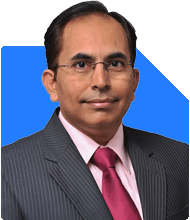Ramalingam Kalirajan |10870 Answers |Ask -Follow
Mutual Funds, Financial Planning Expert - Answered on May 15, 2025
He has an MBA in finance from the University of Madras and is a certified financial planner.
He is the director and chief financial planner at Holistic Investment, a Chennai-based firm that offers financial planning and wealth management advice.... more

Hello Sir, I have a query regarding which is right approach of mentioned two options -I want generate quarterly payout of 15k from a lumpsum investment of 5.5 lac. This is for paying school fees. I'm confused if to invest this lumpsum in a Balanced advanced fund and set up an SWP of 15k quarterly (OR) to put it in a non-cumulative FD that pays out quarterly interest. I'm okay to stay invested for 6 years. Although FD provides the capital preservation but lags in capital appreciation where as BAF has the risk but with time horizon of 6 years, it shall mitigate risk & most importantly returns will still be favourable due to equity component as kicker in BAF Mf's. Your thoughts please... Thank you
You have Rs. 5.5 lakhs in lump sum.
You are considering two options — quarterly payout through SWP in a Balanced Advantage Fund or a non-cumulative Fixed Deposit.
Your investment horizon is 6 years. That gives decent time.
You want capital safety but also better growth. Well analysed thinking from your side.
You are open to taking some risk, which is important for longer-term results.
Let Us Assess the Fixed Deposit Option
FD gives assured interest. That’s good for guaranteed cash flows.
There is no risk of capital loss if held to maturity. That gives peace of mind.
The interest payout every quarter is fixed. You can plan expenses well.
But returns are low after tax. Especially if you are in a high tax bracket.
FD interest is fully taxable as per your slab. That’s a key drawback.
FD returns are flat. So, over 6 years, your capital will not grow.
Inflation reduces real return. That erodes value of money slowly.
You are only withdrawing interest. So, principal stays idle without growing.
Even reinvested interest would earn low return. No scope for capital appreciation.
Now Let Us Evaluate Balanced Advantage Mutual Fund with SWP
These funds shift between equity and debt. They try to reduce downside in markets.
They offer better long-term returns than FD due to equity exposure.
They suit 5–7 year timeframes if you can hold through market cycles.
You can set up SWP of Rs. 15,000 every 3 months. That’s Rs. 60,000 annually.
Over 6 years, you may withdraw Rs. 3.6 lakhs. And capital can still grow.
If fund returns stay healthy, you may have more than Rs. 5.5 lakhs after 6 years.
Tax is lower on capital gains. LTCG up to Rs. 1.25 lakhs per year is tax-free.
Gains above that are taxed at 12.5%, which is much better than FD tax.
SWP is treated as capital redemption. So, only gains part gets taxed.
Therefore, this method gives tax-efficient income. That improves your post-tax return.
Let Us Compare Both Head-To-Head
FD: Low return, high tax, stable income, no capital growth.
BAF+SWP: Moderate return, lower tax, variable income, capital appreciation possible.
FD may be safer. But too safe may not meet your long-term needs.
BAF is not risk-free. But 6 years gives enough time for risk to reduce.
With discipline and patience, BAF can deliver better results than FD.
Fixed Deposit income will stay flat. But school fees will rise over time.
BAF capital may grow, allowing higher SWP in future. That helps in rising fees.
So, with proper SWP planning, you get both income and capital protection.
How to Make SWP Work Better for You
Choose dividend re-investment option, and use only SWP for income.
Withdraw only 3-4% of corpus per year to avoid depleting it.
Review performance every year with your Certified Financial Planner.
Reinvest part of gains back into same fund. That helps compound returns.
Keep emergency funds separately in FD or liquid fund. Do not disturb this corpus.
Important Risk Factors to Remember
Mutual fund returns are not guaranteed. Markets fluctuate.
There may be periods of poor returns. But recovery happens in long term.
You should be emotionally ready to handle short-term volatility.
Equity portion can sometimes fall. But long-term trend is upward.
Choose a regular plan and route it through MFD with CFP support.
Avoid direct plans. They do not give ongoing guidance or active monitoring.
Why You Should Avoid Direct Mutual Funds
Direct funds offer no advisor support. You must do everything yourself.
That includes selection, portfolio review, tax planning, rebalancing.
Many investors end up with wrong choices due to lack of guidance.
Certified Financial Planners bring strategy, experience, and discipline.
Regular plans have a small cost. But they offer lifelong handholding.
For goals like school fees, peace of mind matters more than 0.5% savings.
Emotional support during market falls is also priceless.
Final Insights
You are thinking long term. That is the right mindset.
You want regular income and capital growth. BAF+SWP is better suited.
FD may feel safe. But inflation and taxes make it less efficient.
With 6-year view, Balanced Advantage Fund gives more growth chance.
Do SWP carefully. Avoid high withdrawals in early years.
Review with your Certified Financial Planner every year. Make changes if needed.
Stay invested. Be patient. Do not panic in market dips.
Protect your child’s education fund with a right mix of strategy and guidance.
Keep emotions aside. Let long-term thinking guide you.
Use fund growth smartly. Withdraw only what is needed. Let rest grow.
A hybrid plan like BAF offers flexibility and balance. That suits your goal well.
Continue school fee payments through SWP. Watch your capital grow slowly.
After 6 years, you may have money left over, not just spent. That is success.
Best Regards,
K. Ramalingam, MBA, CFP,
Chief Financial Planner,
www.holisticinvestment.in
https://www.youtube.com/@HolisticInvestment
You may like to see similar questions and answers below
Omkeshwar Singh | Answer |Ask -Follow
Head, Rank MF - Answered on Jan 07, 2022
Milind Vadjikar | Answer |Ask -Follow
Insurance, Stocks, MF, PF Expert - Answered on Jan 24, 2025
Ramalingam Kalirajan |10870 Answers |Ask -Follow
Mutual Funds, Financial Planning Expert - Answered on Mar 13, 2025
Janak Patel |71 Answers |Ask -Follow
MF, PF Expert - Answered on Apr 25, 2025
Ramalingam Kalirajan |10870 Answers |Ask -Follow
Mutual Funds, Financial Planning Expert - Answered on May 15, 2025
Dr Dipankar Dutta |1836 Answers |Ask -Follow
Tech Careers and Skill Development Expert - Answered on Dec 05, 2025
Ulhas Joshi |280 Answers |Ask -Follow
Mutual Fund Expert - Answered on Dec 05, 2025
Dr Dipankar Dutta |1836 Answers |Ask -Follow
Tech Careers and Skill Development Expert - Answered on Dec 04, 2025
Ravi Mittal |676 Answers |Ask -Follow
Dating, Relationships Expert - Answered on Dec 04, 2025
Anu Krishna |1745 Answers |Ask -Follow
Relationships Expert, Mind Coach - Answered on Dec 04, 2025
Anu Krishna |1745 Answers |Ask -Follow
Relationships Expert, Mind Coach - Answered on Dec 04, 2025
Mayank Chandel |2562 Answers |Ask -Follow
IIT-JEE, NEET-UG, SAT, CLAT, CA, CS Exam Expert - Answered on Dec 04, 2025
Mayank Chandel |2562 Answers |Ask -Follow
IIT-JEE, NEET-UG, SAT, CLAT, CA, CS Exam Expert - Answered on Dec 04, 2025
Mayank Chandel |2562 Answers |Ask -Follow
IIT-JEE, NEET-UG, SAT, CLAT, CA, CS Exam Expert - Answered on Dec 04, 2025
Mayank Chandel |2562 Answers |Ask -Follow
IIT-JEE, NEET-UG, SAT, CLAT, CA, CS Exam Expert - Answered on Dec 04, 2025



























